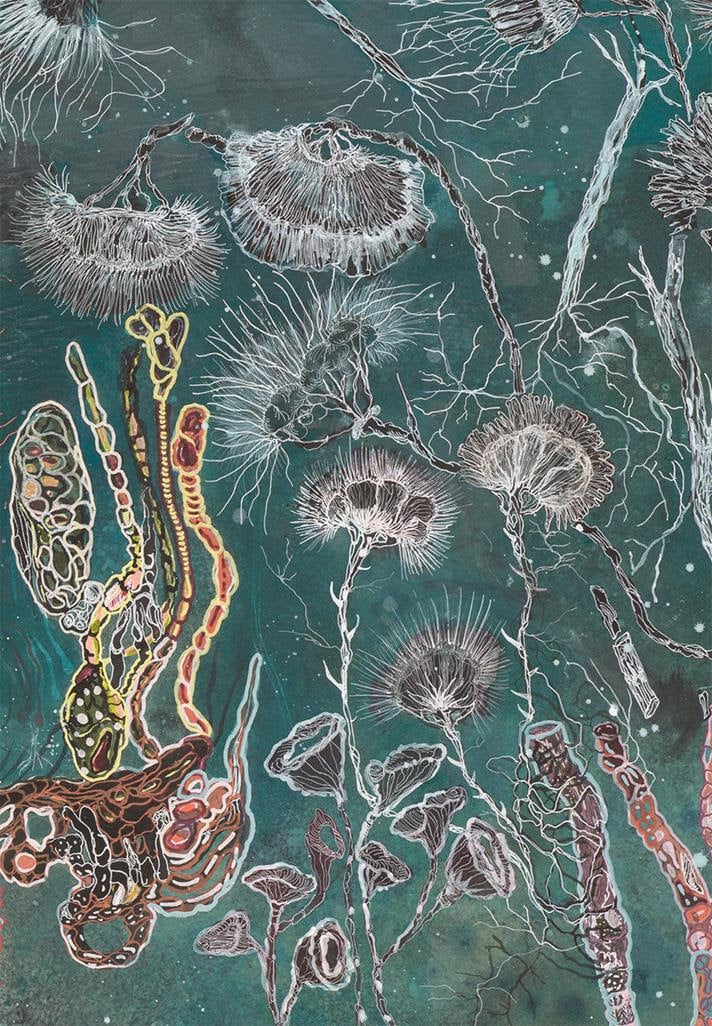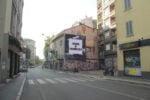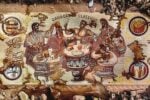Marzia Migliora – Fame d’aria

Il progetto presenta sette nuovi lavori dell’artista, che negli ultimi anni ha approfondito l’inclusione di prospettive multispecie nelle sue ricerche, ovvero cercando di stabilire nuove parentele sensibili, immaginando di guardare alle cose dalle prospettive animali e vegetali.
Comunicato stampa
La Galleria Lia Rumma è lieta di presentare la personale di Marzia Migliora Fame d’aria con inaugurazione domenica 30 Ottobre 2022 alle ore 12 presso la sede di Napoli.
Il progetto presenta sette nuovi lavori dell’artista, che negli ultimi anni ha approfondito l’inclusione di prospettive multispecie nelle sue ricerche, ovvero cercando di stabilire nuove parentele sensibili, immaginando di guardare alle cose dalle prospettive animali e vegetali.
Il titolo della mostra fa riferimento al concetto della fame, come istinto umano che ha mosso, e tuttora muove, dinamiche di sopravvivenza, di appropriazione ed estrattivismo di risorse. Ma si rivolge, in questo contesto, alla fame d’aria, alludendo alla condizione medica che può precedere la morte, ma anche, più in generale, ad una condizione di asfissia diffusa dalla quale doversi separare, indice di una tossicità che non permette la vita, come un ultimo grido prima di volgere lo sguardo altrove, per sopravvivere, appunto, grazie ad un allargarsi della nostra percezione verso un divenire di nuove relazioni tra umano e non umano.
Tra i lavori presentati, la scultura Lek, che proprio su un respiro assistito basa la propria urgenza, dimostrata anche da un assemblaggio di apparente emergenza, che mette insieme pezzi tra di loro eterogenei. Lek, in biologia, è una forma di corteggiamento con la quale i maschi di una specie si esibiscono per il corteggiamento delle femmine, e qui l’incontro d’amore è con il tentativo impossibile di creare una macchina che ci permetta di ascoltare il respiro dei pesci, inudibile ad orecchio umano poiché a 40 hertz, ma basato sul processo di estrarre ossigeno dall’acqua attraverso le branchie, emulato qui dal respiratore medico, di triste attualità in tempi pandemici.
Al centro del percorso Danza per capote de brega, un’altra scultura cinetica che prova a dare forma alla tensione intrisa di violenza che si crea tra un toro ed un torero, attraverso la messa in movimento del capote de brega, ovvero il manto colorato della corrida che fluttua come una membrana tra la vita e la morte dei soggetti coinvolti da questa coreografia.
Run Fast and Bite Hard (entre chain et loup), invece, è un’opera composta da due postazioni che permettono di spiare l’interno di una stanza altrimenti inaccessibile e rappresenta un grande inganno. Si tratta di due miraggi, uno visivo ed uno sonoro, che creano l’illusione di poter accedere ad un bosco, dove osservare, attraverso una video ripresa termica, il passaggio di alcuni lupi o di ascoltare la supposta presenza di diversi uccelli.
Nell’ultima installazione H2O - O2 il rapporto uomo animale è letto attraverso la rappresentazione mediatica che ne ha fatto La domenica del corriere. I collage tridimensionali che popolano i tavoli sono infatti realizzati a partire da eventi di cronaca nei quali animali di ogni specie sono rappresentati come mostri antagonisti della modernità.
Chiude la mostra il numero #50 della serie, in corso dal 2017, de I paradossi dell’abbondanza, nel quale un universo pluricellulare multispecie – che l’artista ha tratto da vari manuali che hanno studiato anatomicamente, dal XIX secolo, tutte le specie dei cinque regni degli esseri viventi – è composto da tessuti, organi e cellule assemblati tra di loro secondo composizioni inedite, non rispondenti alla logica della produzione capitalista che li ha classificati tramite la lente degli allevamenti intensivi, le estrazioni inquinanti o la caccia di massa. Queste nuove forme, inedite e somma di parentele messe insieme ex novo, illuminano una strada possibile, dove, come ci ricorda la filosofa statunitense Donna Haraway “comporre, non accumulare, è la chiave” e dove la morte, che ricorre come un filo rosso in molti dei lavori, è intesa come “parte integrante del buon vivere e morire che condividiamo in quanto creature tentacolari aggrovigliate in una terra feconda”.
Estratto da un saggio di Matteo Lucchetti
Marzia Migliora (Alessandria, 1972), vive e lavora a Torino. Il lavoro di Marzia Migliora si articola attraverso un’ampia gamma di linguaggi che includono la fotografia, il video, il suono, la performance, l’installazione e il disegno. Le sue opere traggono origine da una profonda attenzione per l’individuo e il suo quotidiano. L’artista ha esposto alla Biennale di Venezia 2015 e in mostre in Italia e all’estero tra cui: al MAGA di Gallarate (2020), a Ca’ Rezzonico, Venezia (2017), al Museo d’Arte Contemporanea Castello di Rivoli (2012), al MAXXI di Roma (2012), al Museo del Novecento di Milano (2011), alla Fondazione Merz di Torino (2006), al FACT di Liverpool (2005); al MART di Rovereto (2004), alla Fondazione Sandretto Re Rebaudengo di Torino (2004). I lavori dell’artista fanno parte di collezioni pubbliche e private italiane ed estere: Museo Madre (Napoli), Biedermann Museum (Donaueschingen), The National Museum of Women in the Arts (Washington), Fundaciò Sorigué (Lleida), Museo Castello di Rivoli (Torino), Museo del Novecento (Milano), Sandretto Re Rebaudengo (Torino), Fondazione Merz (Torino), La Triennale (Milano), Collezione ACACIA (Milano), Collezione La Gaia (Cuneo), Videoinsight collection (Torino).
In linea con le attuali normative sanitarie vi invitiamo gentilmente a indossare la mascherina.
The Lia Rumma Gallery is delighted to present Marzia Migliora Fame d’aria, a solo show that opens on Sunday 30 October 2022 at 12.00 pm at its Naples branch.
The project presents seven new works by the artist who has recently explored a multispecies approach in order to create new sensitive relationships, imagining how things might appear from the perspective of animals and plants.
The title of the exhibition refers to the concept of hunger, a human instinct that has had an impact on, and continues to have an impact on, the dynamics of survival, appropriation and “extractivism”, treating Earth as a bundle of resources. However, in this context, she turns her attention to the hunger for air, an allusion to the medical condition that can precede death but also, more generally, to the condition of widespread asphyxia which needs to be left behind as it is an indicator of a level of toxicity that makes life impossible; it is a final cry of alarm before she turns her attention elsewhere, to survive by expanding our perception towards the emergence of new relationships between humans and non-humans.
The works presented in the exhibition include the sculpture Lek which conveys a sense of urgency by being based on assisted breathing, demonstrated by an assemblage seemingly put together in an emergency, featuring pieces that are heterogeneous. In biology, a lek is a space or gathering devoted to courtship in which the males of a species engage in competitive displays to entice females. In this work, the amorous encounter is shown with the impossible attempt to create a machine that makes it possible to hear the breathing of fish, inaudible to the human ear because it has a frequency of 40 hertz, but is based on a procedure of extracting oxygen from water through the gills, emulated here by the medical respirator, sadly very pertinent during an era of pandemics.
At the centre of the exhibition is the work Danza per capote de brega, another kinetic sculpture that seeks to give shape to a tension steeped in the violence created between a bull and a bull-fighter through the moving and waving of the colourful cape used in the corrida which flutters like a membrane between the life and death of the individuals involved in the choreography.
By contrast, Run Fast and Bite Hard (entre chain et loup) is a work consisting of two observation posts that make it possible to spy on the interior of a room (otherwise inaccessible) and represents a great act of deception. These two mirages, one visual and the other sonorous, create the illusion of being able to enter a wood where, by means of a video made using a thermal imaging camera, it is possible to observe wolves passing by or to listen to the putative presence of various birds.
In the final installation H2O - O2 the relationship between humans and animals is interpreted through the depiction of this interaction that appeared in the weekly magazine La domenica del corriere. The three-dimensional collages on the tables are made from news articles in which animals of many different species are portrayed as monsters that stand in the way of modernity
The exhibition culminates in number #50 of the series I paradossi dell’abbondanza. In this series, a multicellular multispecies universe – which the artist has taken from various handbooks based on anatomical studies conducted since the nineteenth century on all the species of the five kingdoms of living creatures – is made up of tissues, organs and cells. They have been assembled using original compositions that do not correspond to the logic of capitalist production which has classified them through the prism of intensive farming, the extraction of resources that cause pollution or large-scale hunting. These new forms, which are completely original and are the result of relationships put together from scratch, shed light on a possible way forward where, as the American philosopher Donna Haraway has reminded us, “composting rather than accumulation is key” and where death, which is a thread running through many of her works, is treated as a “practice of learning to live and die well with each other in a thick present”.
From an essay by Matteo Lucchetti
Marzia Migliora (born in Alessandria in 1972) lives and works in Turin. The work of Marzia Migliora is based on a wide range of languages including photography, video, sound, performance, installation and drawing. Her works originate from the close attention she devotes to individuals and their everyday lives. The artist’s work has been displayed at the Venice Biennale in 2015 and in shows and exhibitions in Italy and abroad including the following: MAGA [Museo Arte] Gallarate (2020), Ca’ Rezzonico, Venice (2017), Museo d’Arte Contemporanea Castello di Rivoli (2012), MAXXI Rome (2012), Museo del Novecento in Milan (2011), Fondazione Merz in Turin (2006), FACT Liverpool (2005); MART in Rovereto (2004), Fondazione Sandretto Re Rebaudengo in Turin (2004). The artist’s works form part of public and private collections in Italy and abroad: Madre Museum (Naples), Biedermann Museum (Donaueschingen), The National Museum of Women in the Arts (Washington), Fundaciò Sorigué (Lleida), Museo Castello di Rivoli (Turin), Museo del Novecento (Milan), Sandretto Re Rebaudengo (Turin), Fondazione Merz (Turin), La Triennale (Milan), Collezione ACACIA (Milan), Collezione La Gaia (Cuneo), Videoinsight collection (Turin).
In line with the current health regulations, we kindly invite visitors to wear a face mask.



